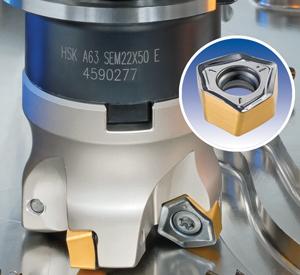- FMA
- The Fabricator
- FABTECH
- Canadian Metalworking
High-feed Milling
Shallow DOC and high-speed toolpaths combine to maximize metal removal
- October 25, 2011
- Article
- Management

High-feed milling uses light depths of cut and above-average feed rates to maximize the amount of metal being removed from a part.
First put into practice by mold and die sector shops, the high-feed milling process uses shallow depths of cut (DOC) and above average feed rates to maximize the amount of metal being removed from a part.
The process can be used in face milling, pocketing, and even helical milling operations.
High-feed milling typically works best with inserts designed specifically for this type of machining. The inserts themselves usually have a shallow lead angle. It’s important that the insert be very strong because of the cutting forces that are created. The size and shape of the insert help to ensure that the cutting forces are directed up the machine’s spindle, minimizing vibration, speeding tool movement, and reducing wear on the machine tool itself.
Because cutting forces are moving up the spindle, there should be no spike in the spindle’s load when the tool moves quickly in and out of a corner cut – a danger in other styles of milling.
By watching the load meter for spikes and looking at the surface finish being produced, you can get a picture of what is happening during the milling operation. Just like in any other type of milling, irregular tool wear, such as notching or thermal deformation, can occur. By keeping an eye out for abnormalities, problems with the cutting process can be spotted easily. Also, using the proper speeds and feeds and applying coolant correctly can eliminate some of these problems.
Insert Evolution
New developments in insert technology have increased the number of ways milling can be performed. As new tools enter the marketplace, shops are no longer limited to a 45-degree or 90-degree cutter for their milling operations.
In Iscar’s case this has resulted in the creation of inserts – the H600 line — with six edges and a 17-degree lead angle configuration. According to the company, this type of angle creates the high stability needed for machining at high feed rates, even in long overhang applications.
It’s not just insert size and shape that can have a positive effect on the high-feed milling process either. Coatings increase lubricity, allowing a higher chip volume to pass over the insert. This is especially important in the so-called gummy materials like nickel alloys and stainless steels that produce long, stringy chips.
According to Tom Hagan, milling product manager for Iscar Tools Canada, the goal in milling is proper chip formation and evacuation.
“Creating optimal chips means that the chip can be evacuated from the cutting zone faster and easier, and it is less likely that the cutter will recut the chips. Getting chips out of the way of the cut is important to both reliability of the tool and the quality of the part,” said Hagan.
Tailoring tooling specifically for the part being created can also help ensure the best possible results are achieved.
“The combination of the correct chip former, geometry, and grade is what enables the fastest possible speed to be used and the maximum metal removal rate to be gained, all with thin depths of cut,” said Hagan. “I like to advise customers to create ‘designated tooling’ for the material that they are cutting and the part they are creating. By selecting the exact, proper tool, you minimize the risk of failure and improve your chances of being competitive.”
The main goal in changing the type of milling procedure you are using is the same as that for buying new tooling: to improve productivity. If you are going to get the same tool life, productivity, and part quality, then there is likely no need for a change. However, if you can improve any of these outcomes, a change in tooling may be beneficial.
“Productivity improvement depends on a lot of factors, but at the end of the day, making a change that reduces the cost per part is definitely paramount,” said Hagan.
The Equipment
Although modern machine tools are much more effective at high-feed milling than their older counterparts, tooling also has been developed for moderate-feed milling on older equipment.
“No matter what type of equipment you have, or how old it is, there are new tooling lines that can make a dramatic improvement in material removal rates,” said Hagan. “Shops should examine the current parameters and compare them to the new technology available. If higher metal removal rates can be achieved, this will result in higher productivity, reducing cycle time and reducing cost per part.”
Having stable fixturing also is important in high-feed milling.
“The more stable the fixturing is, the better chances of higher speeds and feeds being implemented, leading to process optimization,” said Hagan.
Examine the Part
By beginning the process with a close inspection of the part, its material, and form, you can implement the correct tooling setup.
For example, if you’re cutting titanium, 60 to 70 percent of the heat generated is normally transferred to the tool, which dramatically reduces tool life. By using shallow, radial widths of cut, you will transfer less heat to the cutting tool and achieve higher surface speeds. This technique is suitable for roughing titanium, INCONEL® alloys, and other high-temperature alloys that have traditionally required high torque at low RPMs to achieve the desired removal rates.
“Titanium is very prone to chatter, which affects part quality and can cause unpredictable tool failure,” said Dan Cooper, CYCLO CUT® product manager for MAG Regional Services. “By using extremely high feed rates and light radial cuts, we can remove a lot of material with very little risk of scrapping parts.”
MAG’s CYCLO CUT Max-Flute end mills were specifically designed for titanium roughing and feature a 16-flute design capable of high removal rates at low torque.
“The current approach to high-speed machining involves taking very light cuts,” said Cooper. “The [high-feed] approach enables the machine to make heavier cuts at high speeds, and by using the maximum flute density available, maximum feed rates are achievable."
subscribe now


Keep up to date with the latest news, events, and technology for all things metal from our pair of monthly magazines written specifically for Canadian manufacturers!
Start Your Free Subscription- Trending Articles
- Industry Events
ZEISS Quality Innovation Days 2024
- April 15 - 19, 2024
Tube 2024
- April 15 - 19, 2024
- Düsseldorf, Germany
Lincoln Electric's Large Format 3D Metal Printing Seminar
- April 16 - 17, 2024
- Cleveland, OH
CTMA Economic Uncertainty: Helping You Navigate Windsor Seminar
- April 30, 2024
- Windsor, ON Canada
MME Winnipeg
- April 30, 2024
- Winnipeg, ON Canada














